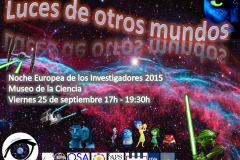 Within the framework of “European Researchers Night 2015” organized by the Science Museum of Valladolid, Physics League has organized a big-workshop related to light because of the IYL2015. Taking advantage of many popular films, the basics of the physical principles can be shown in an attractive and stunning way.
Within the framework of “European Researchers Night 2015” organized by the Science Museum of Valladolid, Physics League has organized a big-workshop related to light because of the IYL2015. Taking advantage of many popular films, the basics of the physical principles can be shown in an attractive and stunning way.
Seven workshops were carried out in parallel in a big space in the Science Museum of Valladolid. The success of the activity was recognized by its directress with more than 500 participants during the event.
- Avatar: Different kinds of luminescence have been explained using the Pandora’s universe: Bioluminescence (natural algae), Chemiluminescence (bracelets) and fluorescence (different paints,minerals).
- Star wars: The holograms are reproduced by a ‘real’ hologram which can be seen with a laser and an ‘optical illusion’ performed by an acetate pyramid. A ‘fight’ between the Jedi (red laser) and Sith (blue laser) sides is performed with tinted fluorescents and plasma balls. How to lead the light is addressed solving a ‘laser khet’ puzzle with only 3 available mirrors.
- Entrapment: a portable laser maze has been built with an Arduino, lasers, and photo-detectors. The light-matter interaction was explained in the entrance.
- Spy kids: some ways to send information are explained. For instance, a spectra sound was built to transmit music using a laser. Polarization of light is shown using 3D-glasses.
- Up: what happens when solar radiation crosses the top of the atmosphere? The radiative effect of clouds and aerosols is shown by a laser, a glass of water, and sugar. Different kinds of aerosols are introduced and a sandstorm is performed in a big box. The role of aerosols as cloud condensation nuclei is proved by the formation of clouds in a bottle with hairspray and warm water.
- Inside Out (workshop I): with 5 atomic spectrum lamps we can explain why we can see colours: Sodium
(‘Joy’, yellow), Zinc (‘Sadness’, blue), Neon (‘Anger’, red), Thalium (‘Disgust’, green), Cesium (‘Fire’, purple). The different aspect of a rainbow inside each box helps to understand the colour absorption/emission. Diffraction is also addressed. - Inside Out (workshop II): how do our eyes work? With a laser kit the human eyes are visually explained. Some problems related to the vision are also detailed. White light is formed by Newton’s disc and decomposed using a prism. Different colour fires go in depth to colour absorption/emission.
[nggallery id=3]
